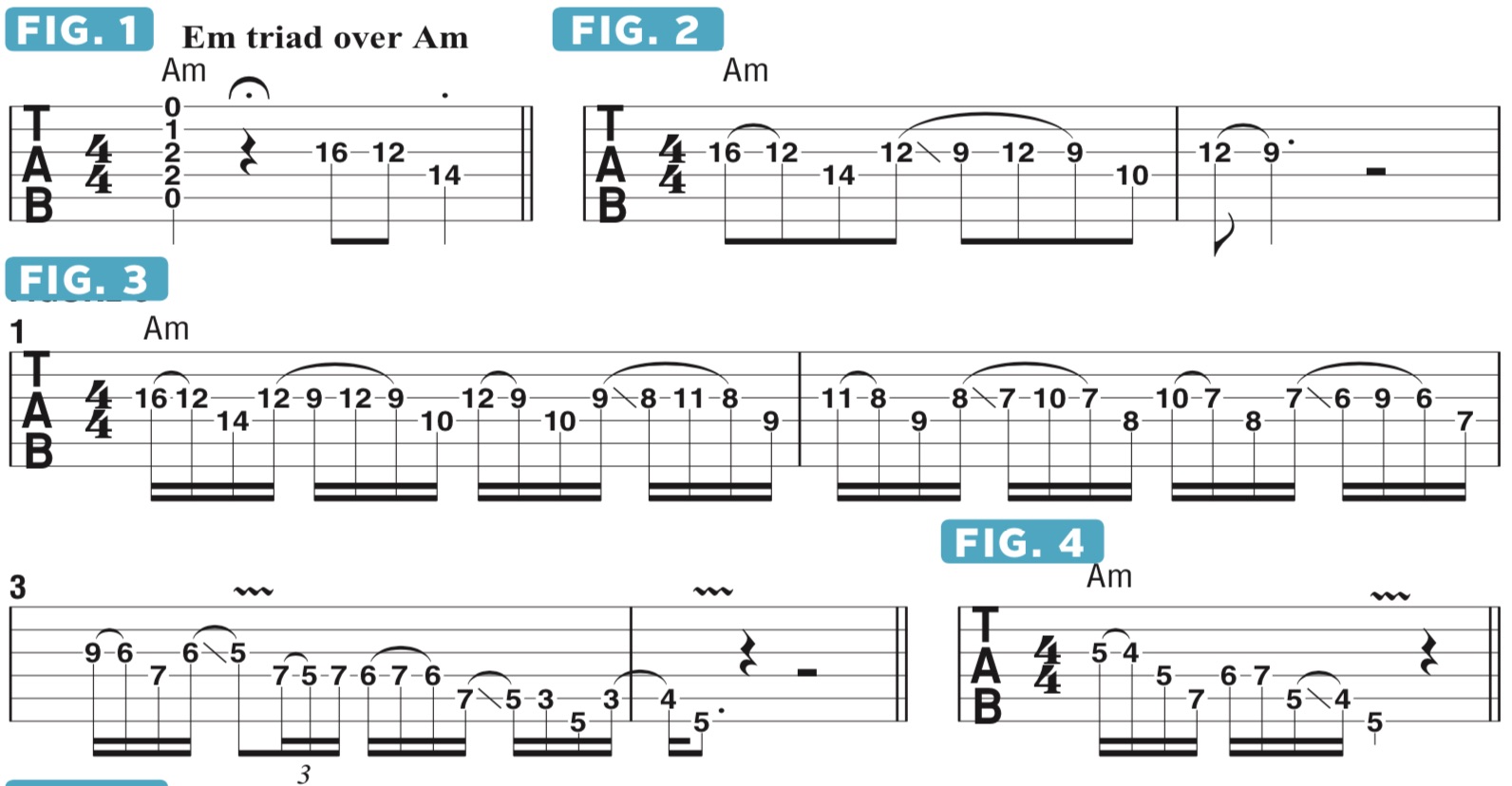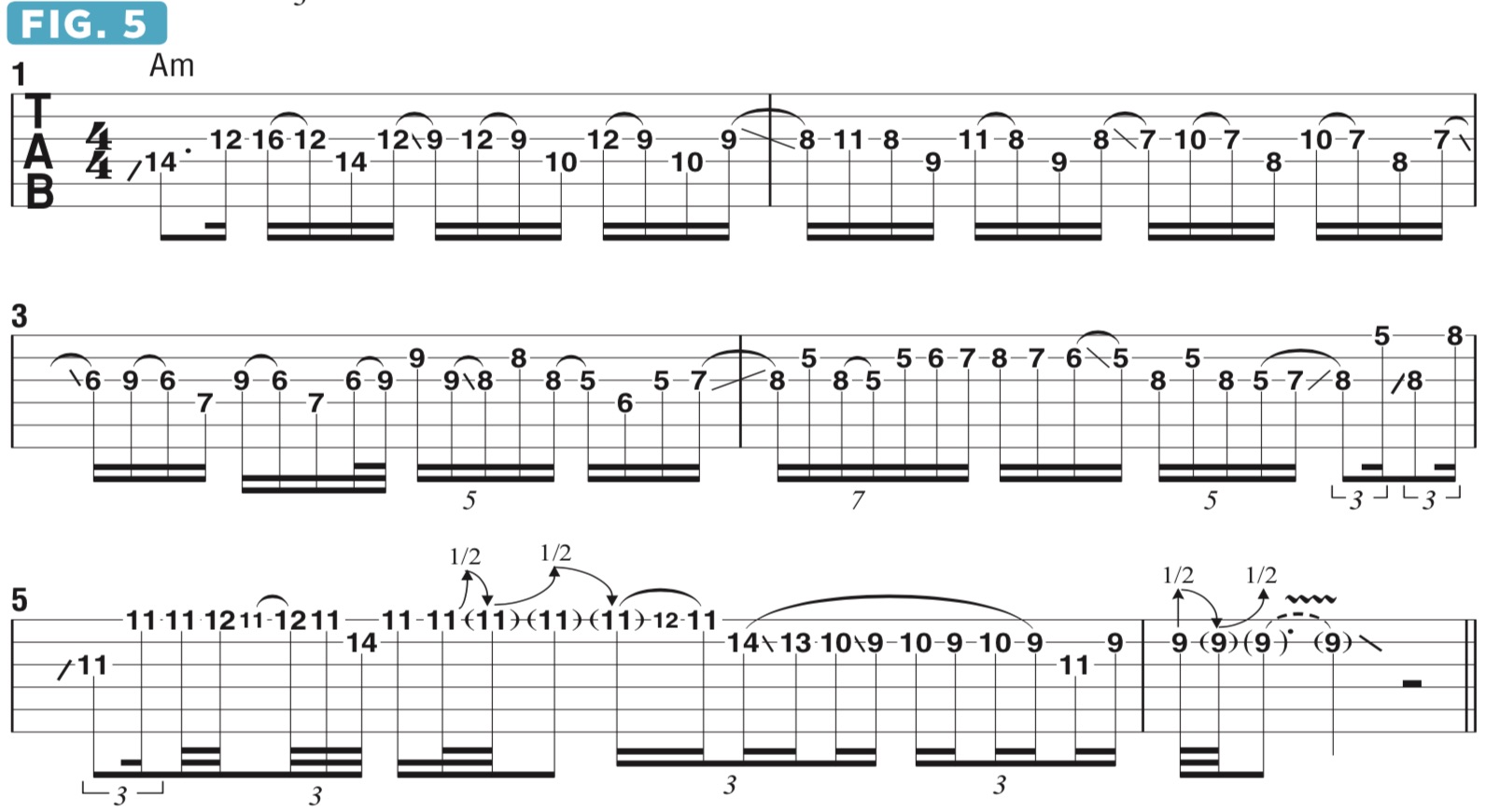Full Shred with Marty Friedman: Relocating Familiar Melodic Ideas and Patterns Up and Down the Fretboard
Take a lick, melodic shape or note sequence that you often use and move it to a different area of the fretboard.
A great way to discover new licks and melodic patterns is to take a lick, melodic shape or note sequence that you often use and move it to different areas of the fretboard.
The benefits of this approach are two-fold. First, the licks and phrases are physically comfortable for you to play because you are already intimately familiar with them.
Second, without the lick posing any new technical challenge, you are more able to focus on hearing how the idea works over a alternate root notes.
For example, if I’m playing in the key of A minor, I might superimpose an E minor triad—E G B—over an A minor tonality, as shown in FIGURE 1. Using this E minor triad shape as a starting point, I could expand the phrase into what’s shown in FIGURE 2. I start with the notes of Em, fretting a high B note on the G string’s 16th fret and then pulling off to G, followed by E on the D string’s 14th fret. I then slide my index finger from G down to E at the ninth fret and use the notes of an Am7 chord, G C E. Now both Em and Am7 chord tones are included in the run, which implies a cool, somewhat jazz-flavored Am9 sound.
If you have been reading this column over the past several months, you know that I am not a fan of cliché riffs and standard licks that so many guitar players rely on. For me, an essential part of expressing oneself on the guitar is to look for new sounds and ideas and to play with a sense of discovery. You don’t want to sound like everyone, or anyone, else, do you? I sure don’t, and one path to originality is to take an idea like this one and simply move it around the fret- board without worrying about “little” things like whether I‘m staying in a certain key or sticking to a specific scale.
As shown in FIGURE 3, I begin with the phrase illustrated in FIGURE 2, but on beat four I slide down one fret and play what had been G E C, now sounding F# D# B. I then repeat this one-fret-descent process two more times, in the process alluding to Gm7 (F D Bb) and F#m7 (E C# A), which can also be interpreted as an A major triad (A C# E). I then wrap up the run with a nod to A minor pentatonic (A C D E G) and a brief inclusion of the major seventh, G#, and the major third, C#.
FIGURE 4 offers another way to create a “minor-to-major” kind of sound. I begin with notes that describe Am9 (C B G E) but wrap up with notes that reference A major (A and C#).

Using these ideas as a basic framework, my natural inclination when soloing would be to play something like FIGURE 5. In bars 1 and 2, I descend the fretboard in a similar manner to FIGURE 3, but in bars 3 and 4 I shift to patterns based roughly on the A blues scale (A C D Eb E G), with a quick nod to Adim7 via the sliding sixths at the end of bar 4 into bar 5. The phrase ends with emphasis on half-step movement, between the note pairs D# and E, C# and C and A and G#.
That’s it for this current round of Full Shred columns. I hope you’ve found the information I’ve offered useful. See you out on the road!

Get The Pick Newsletter
All the latest guitar news, interviews, lessons, reviews, deals and more, direct to your inbox!
“There are so many sounds to be discovered when you get away from using a pick”: Jared James Nichols shows you how to add “snap, crackle and pop” to your playing with banjo rolls and string snaps
Don't let chord inversions bamboozle you. It's simply the case of shuffling the notes around







![Joe Bonamassa [left] wears a deep blue suit and polka-dotted shirt and plays his green refin Strat; the late Irish blues legend Rory Gallagher [right] screams and inflicts some punishment on his heavily worn number one Stratocaster.](https://cdn.mos.cms.futurecdn.net/cw28h7UBcTVfTLs7p7eiLe.jpg)


